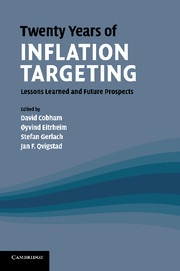Book contents
- Frontmatter
- Contents
- List of figures
- List of tables
- List of contributors
- 1 Introduction
- 2 Welcome remarks: a Norwegian perspective
- 3 Reflections on inflation targeting
- 4 Inflation targeting at twenty: achievements and challenges
- 5 Inflation targeting twenty years on: where, when, why, with what effects and what lies ahead?
- 6 How did we get to inflation targeting and where do we need to go to now? A perspective from the US experience
- 7 Inflation control around the world: why are some countries more successful than others?
- 8 Targeting inflation in Asia and the Pacific: lessons from the recent past
- 9 Inflation targeting and asset prices
- 10 The optimal monetary policy instrument, inflation versus asset price targeting, and financial stability
- 11 Expectations, deflation traps and macroeconomic policy
- 12 Heterogeneous expectations, learning and European inflation dynamics
- 13 Inflation targeting and private sector forecasts
- 14 Inflation targeting, transparency and inflation forecasts: evidence from individual forecasters
- 15 Gauging the effectiveness of quantitative forward guidance: evidence from three inflation targeters
- 16 Macro-modelling with many models
- 17 Have crisis monetary policy initiatives jeopardised central bank independence?
- 18 Inflation targeting: learning the lessons from the financial crisis
- 19 The financial crisis as an opportunity to strengthen inflation-targeting frameworks
- 20 ‘Leaning against the wind’ is fine, but will often not be enough
- 21 Inflation targeting, capital requirements and ‘leaning against the wind’: some comments
- Index
16 - Macro-modelling with many models
Published online by Cambridge University Press: 05 October 2010
- Frontmatter
- Contents
- List of figures
- List of tables
- List of contributors
- 1 Introduction
- 2 Welcome remarks: a Norwegian perspective
- 3 Reflections on inflation targeting
- 4 Inflation targeting at twenty: achievements and challenges
- 5 Inflation targeting twenty years on: where, when, why, with what effects and what lies ahead?
- 6 How did we get to inflation targeting and where do we need to go to now? A perspective from the US experience
- 7 Inflation control around the world: why are some countries more successful than others?
- 8 Targeting inflation in Asia and the Pacific: lessons from the recent past
- 9 Inflation targeting and asset prices
- 10 The optimal monetary policy instrument, inflation versus asset price targeting, and financial stability
- 11 Expectations, deflation traps and macroeconomic policy
- 12 Heterogeneous expectations, learning and European inflation dynamics
- 13 Inflation targeting and private sector forecasts
- 14 Inflation targeting, transparency and inflation forecasts: evidence from individual forecasters
- 15 Gauging the effectiveness of quantitative forward guidance: evidence from three inflation targeters
- 16 Macro-modelling with many models
- 17 Have crisis monetary policy initiatives jeopardised central bank independence?
- 18 Inflation targeting: learning the lessons from the financial crisis
- 19 The financial crisis as an opportunity to strengthen inflation-targeting frameworks
- 20 ‘Leaning against the wind’ is fine, but will often not be enough
- 21 Inflation targeting, capital requirements and ‘leaning against the wind’: some comments
- Index
Summary
Introduction
We argue that macro-models in inflation-targeting central banks are too narrowly focused to provide accurate probabilistic forecasts. Despite the explicit consideration of model uncertainty afforded by Bayesian estimation techniques, the models prominent in central banks devote insufficient attention to ‘uncertain instabilities’. Too much consideration is paid to refining a single preferred but inevitably misspecified model. A product of this oversight is that the 2007-vintage workhorse monetary policy models had little (or nothing) to say about the probability of ‘tail’ events, which now dominate the debate over the causes of, and remedies for, the recent global financial crisis.
In our view, the next generation of macro-modellers should address this deficiency while preserving the architecture of dynamic non-linear modelling. We propose a methodology adapted from the weather-forecasting literature known as ‘ensemble modelling’. In this approach, uncertainty about model specifications – e.g. initial conditions, parameters and boundary conditions – are explicitly accounted for by constructing ensemble predictive densities from a large number of component models. The components allow the modeller to explore a wide range of uncertainties; and the resulting ensemble ‘integrates out’ these uncertainties using time-varying post-data weights on the components.
We provide two economic examples of the ensemble methodology. In the first, we consider a policymaker (recursively) selecting a linear combination of disaggregate predictives to produce an ensemble forecast density for inflation. Each component of the ensemble comprises a univariate autoregressive model using a single disaggregate series.
- Type
- Chapter
- Information
- Twenty Years of Inflation TargetingLessons Learned and Future Prospects, pp. 398 - 418Publisher: Cambridge University PressPrint publication year: 2010
- 6
- Cited by



